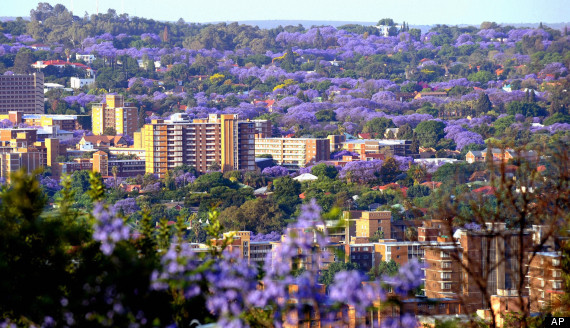Introduction
Pretoria is located in the north east of South Africa, to the north of Gauteng, and 60 Kilometres away from the north east of Johannesburg [i] . As the administrative capital of South Africa, [ii] Pretoria has many government buildings built of sandstone. [iii] There is also a strong Afrikaner presence in Pretoria, thus the Afrikaans language is dominant. [iv]
Pretoria or Tshwane?
In the mid-2000s Pretoria was at the centre of controversy when it was decided that the name of Pretoria should be changed to ‘Tshwane’. Because of South Africa’s history of Apartheid and the racism embedded in the country’s institutions, many South Africans felt that the name needed to change in order to reflect transformation in the country. Others maintained that the name ‘Pretoria’ was of historical significance. Tshwane, a Setswana word for ‘we are the same’, [v] is also believed to be the name of the son of a local Nguni pre-colonial headman, chief Musi, who had lived in the east of Pretoria in the late 1700s or early 1800s. [vi] A second theory argues that the name stems from the Sesotho saLebua word tshwenyana, which refers to a monkey. [vii] This word might have then been translated into the Afrikaans equivalent of apies (apes), the name that the Afrikaans population gave to a local river in Pretoria, the Apies River. [viii]
On 21 May 2005 thousands of protesters, who were predominantly White, marched through Tshwane / Pretoria protesting against the renaming of the city. [ix] The issue of pleknaamverandering (Afrikaans for name-changing) then became very popular in the media, especially in the Afrikaans press, particularly Beeld. [x]
In the meanwhile the [xi] The ANC further argued that its policy of renaming places was a brave step towards breaking the past. [xii]
The Afrikaans population, however, argued that the name-changing policy was only targeted at changing the Afrikaans names. [xiii] They asserted that the British names were left largely untouched, for instance Grahamstown in the Eastern Cape, which is named after John Graham, the architect of the slaughter of numerous Xhosas in the region. [xiv] The Afrikaans community further pointed out that some places with Afrikaans names, which had no political connotations, such as Spruit ('small stream’), were rendered unofficial and were also going to be changed. [xv]
Notwithstanding all this dissent, in 2005 the name Pretoria was changed to Tshwane. [xvi] This new name was approved on 26 May 2005, by the South African Geographical Names Council (SAGNC), but was later rejected by many of Pretoria’s citizens. [xvii] Even though Pretoria was officially renamed Tshwane, migration from the name Pretoria to Tshwane has proven to be challenging for many business organisations, media and other institutions both locally and internationally [xviii]. This is why the city is still commonly referred to as Pretoria. [xix]
Pretoria is also popularly referred to as ‘Jacaranda City’, stemming from the fact the city has over 50 000 purple Jacaranda trees, which line the streets and fill the parks of the city. These trees bloom beautifully in October of each year. [xx]
 Another name for the Pretoria is “Jacaranda city”. This name comes from the fact that the city has over 50 000 of purple Jacaranda trees which are planted in the streets and parks of the city. Image source
Another name for the Pretoria is “Jacaranda city”. This name comes from the fact that the city has over 50 000 of purple Jacaranda trees which are planted in the streets and parks of the city. Image source
Endnotes
[i] Fine, V. & Vidar, J. 2011.South Africa, Lesotho and Swaziland. Modernoverland, p. 403. ↵
[ii] Ibid. ↵
[iii] Ibid.p. 402. ↵
[iv] Ibid. ↵
[v] Ibid. ↵
[vi] Jenkins, E. 2007.Falling into place, the story of South African modern Names.Claremont: David Philip Publishers. p. 158. ↵
[vii] Ibid. ↵
[viii] Ibid. ↵
[ix] Norman, J. 2008.Language policy and nation building in the post-apartheid era South Africa. Springer Science+Science Media B.V. ,p.126. ↵
[x] Ibid. ↵
[xi] Ibid. ↵
[xii] Ibid. ↵
[xiii] Ibid. ↵
[xiv] Ibid. ↵
[xv] Ibid. ↵
[xvi] Maitland, R. & Brent, W. (eds.)2009.City Tourism National Capital Perspectives. Wallingford:Cab International. p. 66. ↵
[xvii] Ibid. ↵
[xviii] Lubbe, J. & du Plessis, T. 2008. South African Language Rights Monitor. Bloemfontein: SUN Press, p27. ↵
[xix] Maitland, R. & Brent, W. (eds.).2009.City Tourism National Capital Perspectives. Wallingford: Cab International. P. 67. ↵
[xx] Joyce, P.2006.Traveller’s Guide South Africa. Cape Town: New Holland Publishers. p 38. ↵

